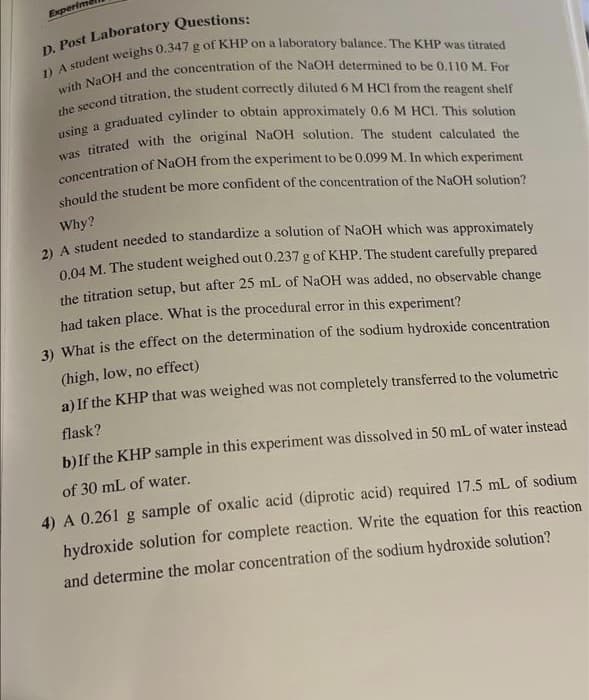had taken place. What is 3) What is the effect on the determination of the sodium hydroxide concentration (high, low, no effect) a) If the KHP that was weighed was not completely transferred to the volumetric flask? b) If the KHP sample in this experiment was dissolved in 50 mL of water instead of 30 mL of water. of oralic acid (diprotic acid) required 17.5 mL of sodium
had taken place. What is 3) What is the effect on the determination of the sodium hydroxide concentration (high, low, no effect) a) If the KHP that was weighed was not completely transferred to the volumetric flask? b) If the KHP sample in this experiment was dissolved in 50 mL of water instead of 30 mL of water. of oralic acid (diprotic acid) required 17.5 mL of sodium
Chapter15: Acid-base Equilibria
Section: Chapter Questions
Problem 13Q: An acid is titrated with NaOH. The following beakers are illustrations of the contents of the beaker...
Related questions
Question
Solve 3 and 4

Transcribed Image Text:Experim
D. Post Laboratory Questions:
1) A student weighs 0.347 g of KHP on a laboratory balance. The KHP was titrated
with NaOH and the concentration of the NaOH determined to be 0.110 M. For
the second titration, the student correctly diluted 6 M HCI from the reagent shelf
using a graduated cylinder to obtain approximately 0.6 M HCI. This solution
was titrated with the original NaOH solution. The student calculated the
concentration of NaOH from the experiment to be 0.099 M. In which experiment
should the student be more confident of the concentration of the NaOH solution?
Why?
2) A student needed to standardize a solution of NaOH which was approximately
0.04 M. The student weighed out 0.237 g of KHP. The student carefully prepared
the titration setup, but after 25 mL of NaOH was added, no observable change
had taken place. What is the procedural error in this experiment?
3) What is the effect on the determination of the sodium hydroxide concentration
(high, low, no effect)
a) If the KHP that was weighed was not completely transferred to the volumetric
flask?
b) If the KHP sample in this experiment was dissolved in 50 mL of water instead
of 30 mL of water.
4) A 0.261 g sample of oxalic acid (diprotic acid) required 17.5 mL of sodium
hydroxide solution for complete reaction. Write the equation for this reaction
and determine the molar concentration of the sodium hydroxide solution?
Expert Solution
This question has been solved!
Explore an expertly crafted, step-by-step solution for a thorough understanding of key concepts.
This is a popular solution!
Trending now
This is a popular solution!
Step by step
Solved in 2 steps with 1 images

Knowledge Booster
Learn more about
Need a deep-dive on the concept behind this application? Look no further. Learn more about this topic, chemistry and related others by exploring similar questions and additional content below.Recommended textbooks for you


Chemistry: An Atoms First Approach
Chemistry
ISBN:
9781305079243
Author:
Steven S. Zumdahl, Susan A. Zumdahl
Publisher:
Cengage Learning

Chemistry
Chemistry
ISBN:
9781305957404
Author:
Steven S. Zumdahl, Susan A. Zumdahl, Donald J. DeCoste
Publisher:
Cengage Learning


Chemistry: An Atoms First Approach
Chemistry
ISBN:
9781305079243
Author:
Steven S. Zumdahl, Susan A. Zumdahl
Publisher:
Cengage Learning

Chemistry
Chemistry
ISBN:
9781305957404
Author:
Steven S. Zumdahl, Susan A. Zumdahl, Donald J. DeCoste
Publisher:
Cengage Learning

Chemistry: Principles and Practice
Chemistry
ISBN:
9780534420123
Author:
Daniel L. Reger, Scott R. Goode, David W. Ball, Edward Mercer
Publisher:
Cengage Learning


Introductory Chemistry: A Foundation
Chemistry
ISBN:
9781337399425
Author:
Steven S. Zumdahl, Donald J. DeCoste
Publisher:
Cengage Learning